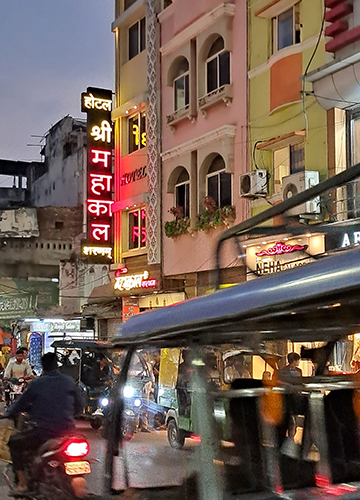Shiva looms large in Ujjain. The screen of the autorickshaw that I take to the Mahakaleshwar Temple has “Jai Shree Mahakal” printed on it. And the security guard who ushers me into the compound chants the mantra.
It is a crisp spring morning, and a state-of-the-art sound system fills the air with “Om”. I am at Nandi Dwar, a 26ft-high gate that opens to a 900m corridor leading to the centuries-old temple. Both the gate and the corridor are designed to dwarf visitors.
The corridor is the longest of its kind in the country. It is being constructed along the banks of the Rudra Sagar lake and the river Kshipra at a cost of more than Rs850 crore. Named ‘Mahakal Lok’, the corridor will have 200 statues and a 100ft-wide mural wall.
Beyond Nandi Dwar is a lotus pond. In the middle is a towering statue of a meditating Shiva surrounded by gushing fountains.
As many as 108 stambhas (pillars) line the corridor. Made of sandstone from Rajasthan, the stambhas have carvings of Shiva performing anand tandav. The tallest is the 54ft-high Shiv Stambh, which is higher than the famous Hollywood sign in Los Angeles (45ft). Atop the Shiv Stambh is a panchmukhi, or five-faced Shiva.
Visitors usually take around two hours to explore the corridor. At the end of the passage is the grand temple, its dome hidden by the roof of a waiting hall. Meant to decongest the temple premises, the hall has devotees queuing up, chanting “Jai Shree Mahakal”.
Beautifying the temple is the next phase of the project. For now, unlike the modern and ordered path to the temple, the mandir area retains an old flavour. Roads are narrow, autorickshaws jostle for space, and shopkeepers hawk sundry items―from incense sticks made of flowers offered to the temple, to momos, panipuri and ice cream.
Elderly women carrying red and yellow pots―denoting the colour of the sandal paste in them―sit on the pavement. They look for devotees who want to ‘mark’ their spiritual experience on their forehead. A devotee, Rajiv of Jaipur, gets the word Mahakal drawn on his forehead in yellow for 020. Rajiv’s son captures the process on his cellphone. “The number of devotees visiting the temple has increased manifold after the prime minister inaugurated the corridor last year,” says Rajiv.
The Mahakaleshwar Temple holds special significance for Hindus. It is believed to have one of the 12 jyotirlingas (pillars of light) in India. Also, the jyotirlinga in Ujjain is the only one facing the south; all others face the east. Hence its fame as dakshinamukhi.
The temple’s name, too, has a deeper meaning. The Sanskrit word kala refers to both time and death. As the one who conquered both, Shiva was called Mahakal.
His abode in Ujjain is also interlinked with the concept of space-time. In ancient times, Ujjain was considered as the place where the prime meridian and the tropic of Cancer intersected. In the 18th century, Maharaja Jai Singh II built an observatory with 13 architectural instruments to study astronomical phenomena. The place is known as Jantar Mantar or Vedh Shala.
With the Mahakal Lok corridor, Ujjain has added another layer to its deep links with time and space, and the physical and the philosophical.


